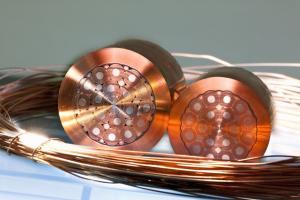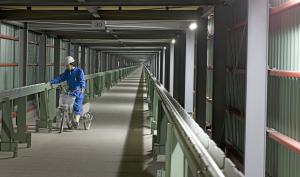Superconductivity: it gets the current flowing
To create the optimal conditions for fusion in a tokamak, the hot gas (plasma) must be confined in the centre of the vessel. This is the job of powerful magnetic fields, which are created by large electromagnets.

At JET, the biggest operating tokamak in the world, the energy consumption of the electromagnets is on the order of 150 MW—one-sixth of the power delivered by a standard nuclear plant.
Although acceptable for short periods in an experimental machine, this kind of consumption would disqualify, in economic terms, the type of large, commercial fusion reactor that is expected in the second half of this century.
For the economics of fusion to be viable, reducing the consumption of the magnets becomes absolutely necessary.
The amount of energy a magnet consumes is directly related to the notion of electrical resistance, or the collision between particles. Even in a conducting metal, like copper, collisions create resistance and resistance creates heat that must be evacuated; what's more, the energy lost must continuously be replaced. Without resistance, electrical consumption would drop to zero and, as an added advantage, no heat would be created in the magnets.
It was in 1911 that Dutch particle physicist Heike Kamerlingh Onnes discovered, practically by accident, that once certain metals were cooled to very low temperatures, resistance dropped to zero.
Called "superconductivity," this discovery remained without practical applications for decades. Following theoretical advances in the 1950s, as well as new discoveries in material science, superconductivity began to revolutionize medical imagery, profoundly change particle physics, and open the way to a viable industrial and commercial future for fusion energy.
All of the large fusion devices built since the late 1980s—the LHD stellarator (Japan) and the tokamaks Tore Supra (France), EAST (China), KSTAR (Korea) and SST-1 (India)—are equipped with superconducting magnets. And it goes without saying that projects under construction—such as the W7-X stellarator (Germany), the JT-60 SA (Japan) and, of course, ITER—will also rely on superconducting magnets to carry higher current and produce stronger magnetic field than conventional counterparts, while consuming less power.
"If ITER's magnets were made from copper, like JET's, we would need a 800 MW nuclear reactor just to feed them," says Arnaud Devred, who is in charge of superconducting systems at ITER. "What's more, they would heat up incredibly quickly. With superconducting technology, only the cryogenic plant responsible for cooling the magnets to superconducting temperatures will require energy (20 MW)."
The niobium-tin or niobium-titanium alloys used for the superconducting wire in ITER's magnets become superconducting at temperatures on the order of -270 °C—the temperature of liquid helium. (That's colder than the dark side of the Moon.)
In a conventional superconducting magnet system, the magnets are immersed in the liquid that cools them. But ITER's magnet systems will be far too large for that (24 m in diameter for the largest poloidal field magnet and 17 metres high for the toroidal field magnets).
To solve this dilemma, in the mid-1970s fusion scientists and engineers developed a new type of superconducting cable. Called "cable-in-conduit" conductors, the superconducting cable is enclosed in a metal jacket and a forced flow of liquid helium circulates in a central channel.
The sheer quantity of superconductors required for ITER has invigorated the world market. ITER will use more than one-fifth of the annual production of niobium-titanium strands (275 tons), and the global production of niobium-tin strands has been multiplied by six to meet ITER's needs (on the order of 600 tons).
"Thanks to superconductivity," says Arnaud, "physicists have been able to develop instruments that are exploring the limits of scientific knowledge."
Applied to fusion, superconductivity—the "miracle of physics"—has enabled the construction of larger machines without costly electrical consumption. Without it, fusion would have remained a laboratory science ...


